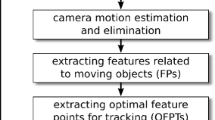Abstract
In dynamic scenes with occluding objects many features need to be tracked for a robust real-time camera pose estimation. An open problem is that tracking too many features has a negative effect on the real-time capability of a tracking approach. This paper proposes a method for the feature management which performs a statistical analysis of the ability to track a feature and then uses only those features which are very likely to be tracked from a current camera position. Thereby a large set of features in different scales is created, where every feature holds a probability distribution of camera positions from which the feature can be tracked successfully. As only the feature points with the highest probability are used in the tracking step, the method can handle a large amount of features in different scale without losing the ability of real time performance. Both the statistical analysis and the reconstruction of the features’ 3D coordinates are performed online during the tracking and no preprocessing step is needed.
Preview
Unable to display preview. Download preview PDF.
Similar content being viewed by others
References
Najafi, H., Genc, Y., Navab, N.: Fusion of 3d and appearance models for fast object detection and pose estimation. In: Narayanan, P.J., Nayar, S.K., Shum, H.-Y. (eds.) ACCV 2006. LNCS, vol. 3852, Springer, Heidelberg (2006)
Bleser, G., Pastarmov, Y., Stricker, D.: Real-time 3d camera tracking for industrial augmented reality applications. In: WSCG (Full Papers), pp. 47–54 (2005)
Genc, Y., Riedel, S., Souvannavong, F., Akinlar, C., Navab, N.: Marker-less tracking for ar: A learning-based approach. In: IEEE / ACM International Symposium on Mixed and Augmented Reality. pp. 295–304. IEEE Computer Society Press, Los Alamitos (2002)
Davison, A.: Real-time simultaneous localisation and mapping with a single camera. In: Proc. International Conference on Computer Vision, Nice (2003)
Bleser, G., Wuest, H., Stricker, D.: Online camera pose estimation in partially known and dynamic scenes. In: ISMAR, pp. 56–65 (2006)
Shi, J., Tomasi, C.: Good features to track. In: CVPR 1994. IEEE Conference on Computer Vision and Pattern Recognition, pp. 593–600. IEEE Computer Society Press, Los Alamitos (1994)
Jin, H., Favaro, P., Soatto, S.: Real-Time feature tracking and outlier rejection with changes in illumination. In: IEEE Intl. Conf. on Computer Vision. pp. 684–689. IEEE Computer Society Press, Los Alamitos (2001)
Matthews, I., Ishikawa, T., Baker, S.: The template update problem. IEEE Transactions on Pattern Analysis and Machine Intelligence 26(6), 810–815 (2004)
Zinßer, T., Gräßl, C., Niemann, H.: Efficient Feature Tracking for Long Video Sequences. In: Rasmussen, C.E., Bülthoff, H.H., Schölkopf, B., Giese, M.A. (eds.) DAGM 2004. LNCS, vol. 3175, pp. 326–333. Springer, Heidelberg (2004)
Scott, D.W., Szewczyk, W.F.: From kernels to mixtures. Technometrics. 43, 323–335 (2001)
Goldberger, J., Roweis, S.: Hierarchical clustering of a mixture model. In: Saul, L.K., Weiss, Y., Bottou, L. (eds.) Advances in Neural Information Processing Systems 17, pp. 505–512. MIT Press, Cambridge (2005)
Zhang, K., Kwok, J.: Simplifying mixture models through function approximation. In: Schölkopf, B., Platt, J., Hoffman, T. (eds.) Advances in Neural Information Processing Systems 19, MIT Press, Cambridge (2007)
Zivkovic, Z., van der Heijden, F.: Recursive unsupervised learning of finite mixture models. IEEE Trans. Pattern Anal. Mach. Intell. 26(5), 651–656 (2004)
Harris, C., Stephens, M.: A combined corner and edge detector. In: Proc. Alvey Vision Conf, Univ, Manchester, pp. 147–151 (1988)
Rosten, E., Drummond, T.: Fusing points and lines for high performance tracking. In: IEEE International Conference on Computer Vision, vol. 2, pp. 1508–1511 (2005)
Author information
Authors and Affiliations
Editor information
Rights and permissions
Copyright information
© 2007 Springer-Verlag Berlin Heidelberg
About this paper
Cite this paper
Wuest, H., Pagani, A., Stricker, D. (2007). Feature Management for Efficient Camera Tracking. In: Yagi, Y., Kang, S.B., Kweon, I.S., Zha, H. (eds) Computer Vision – ACCV 2007. ACCV 2007. Lecture Notes in Computer Science, vol 4843. Springer, Berlin, Heidelberg. https://doi.org/10.1007/978-3-540-76386-4_73
Download citation
DOI: https://doi.org/10.1007/978-3-540-76386-4_73
Publisher Name: Springer, Berlin, Heidelberg
Print ISBN: 978-3-540-76385-7
Online ISBN: 978-3-540-76386-4
eBook Packages: Computer ScienceComputer Science (R0)




